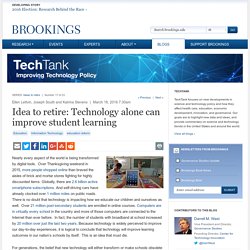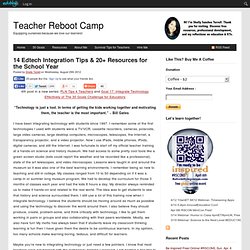

TPACK.ORG. Idea to retire: Technology alone can improve student learning. Nearly every aspect of the world is being transformed by digital tools.

Over Thanksgiving weekend in 2015, more people shopped online than braved the aisles of brick and mortar stores fighting for highly discounted items. Globally, there are 2.6 billion active smartphone subscriptions. And self-driving cars have already clocked over 1 million miles on public roads. There is no doubt that technology is impacting how we educate our children and ourselves as well.
Over 21 million post-secondary students are enrolled in online courses. For generations, the belief that new technology will either transform or make schools obsolete has persisted. For example, there is a belief that students today are “digital natives” and as technology-savvy, multi-tasking, always-on individuals, they don’t need to be taught how to use technology effectively in order to learn. National Education Technology Plan.
Contribute to the 2021 NETP Development If you would like to contribute to the development of the 2021 NETP, please share your thoughts here:Share your Input 2021 National Education Technology Plan The U.S. Department of Education is committed to leveraging the power of technology to rethink education and approach student learning in new ways. To support this goal, the Office of Educational Technology is working to update and expand upon the vision presented in the 2017 NETP to ensure its relevance and usefulness based on the policy, funding and social contexts within which digital learning now occurs.
Exploring the BYOD Trend in Education. 40 Ways Education Technology Will Be Used In The Future. Do you know what technology you’ll be using in the classroom 5 years from now? What about 10 years from now? A new visualization may be able to help. Thanks to the hard work by Envisioning Tech , it’s simple to see what we could expect to happen in the next few decades. From today’s iPads to holograms in the year 2040, there’s a lot coming to a classroom near you. Better still, the visualization below is categorized into color-coded topics. Want to post this up in the teacher’s lounge or on your desk?
Why It's Time To Start BYOD In Your School. I remember fondly, my time as a young and plucky probationary teacher. Exploring the realities of classroom practice and experimenting with new pedagogy. I recall quite clearly the time when my first classroom was equipped with a single desktop computer. Today, it is equipped with 30 desktop computers, a projector, an interactive whiteboard, a visualiser, an A3 colour printer, a laser printer and even a 3D Printer. The Gradual Shift Yet, one could argue that somewhere on this journey, my pedagogy has lost focus and that there remains disconnect between my ambition for interactive learning through technology and the realities of my practice.
Let’s explore this concept… www.tomorrow.org/speakup/pdfs/Infographic_PersonalizedLearning2012.pdf. How To Know If You're Correctly Integrating Technology. A common question that we hear from teachers about integrating technology into their classrooms is, “how do I know if I’m doing it right?” We love to hear this question because that tells us that the teacher is starting to analyze and evaluate how they are integrating technology and are looking for a way to gauge their effectiveness. We feel that the Technology Integration Matrix (TIM) best addresses the question of “doing it right.” According to the Arizona K-12 Center at Northern Arizona University , “the TIM is designed to assist schools and districts in evaluating the level of technology integration in classrooms and to provide teachers with models of how technology can be integrated throughout instruction in meaningful ways.”
There is more than one version of the TIM but the one that we most commonly refer to with our staff was produced by the Arizona K12 Center at NAU. www.tomorrow.org/speakup/pdfs/Infographic_DigitalLearning2012_Educators.pdf. Digital Promise - Accelerating Innovation in Education. 14 Edtech Integration Tips & 20+ Resources for the School Year. 4th post in a new series: PLN Tips 4 Teachers and Goal 17: Integrate Technology Effectively of The 30 Goals Challenge for Educators “Technology is just a tool.

In terms of getting the kids working together and motivating them, the teacher is the most important.” ~ Bill Gates I have been integrating technology with students since 1997. I remember some of the first technologies I used with students were a TV/VCR, cassette recorders, cameras, polaroids, large video cameras, large desktop computers, microscopes, telescopes, the Internet, a transparency projector, and a video projector. Now I use iPads, mobile phones, iPods, digital cameras, and still the Internet. Maybe you’re new to integrating technology or just need a few pointers.
More Tips & 20+ Resources Beyond the first tip of connecting online and learning from other educators, I offer the following tips from my PLN, which are in no particular order: Tip: Assess if you need to use the technology. Tip: Get ideas from other teachers. YouTube. WEBINAR April 23: Digital Learning: Student Voices Heard. National Education Technology Plan 2010.